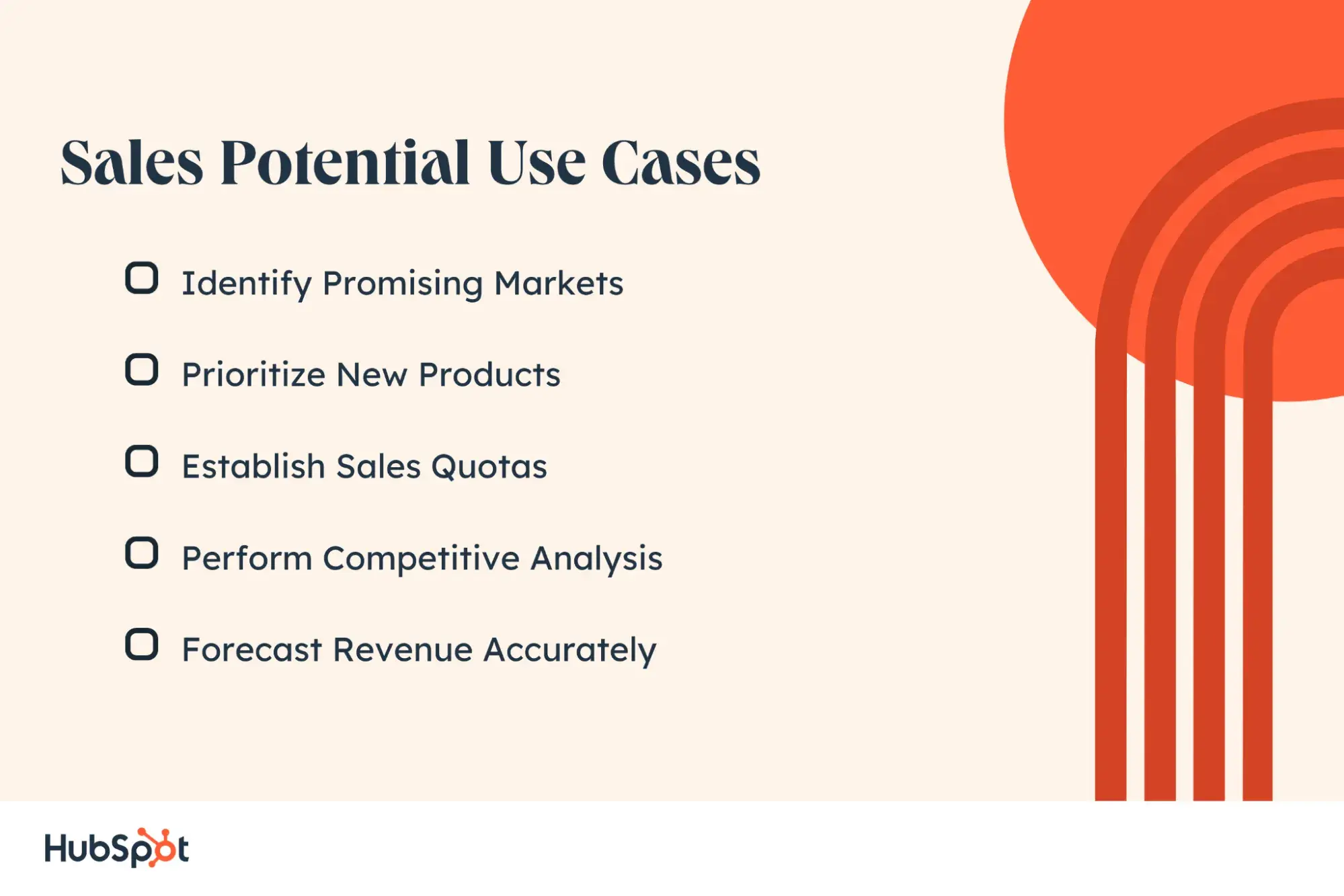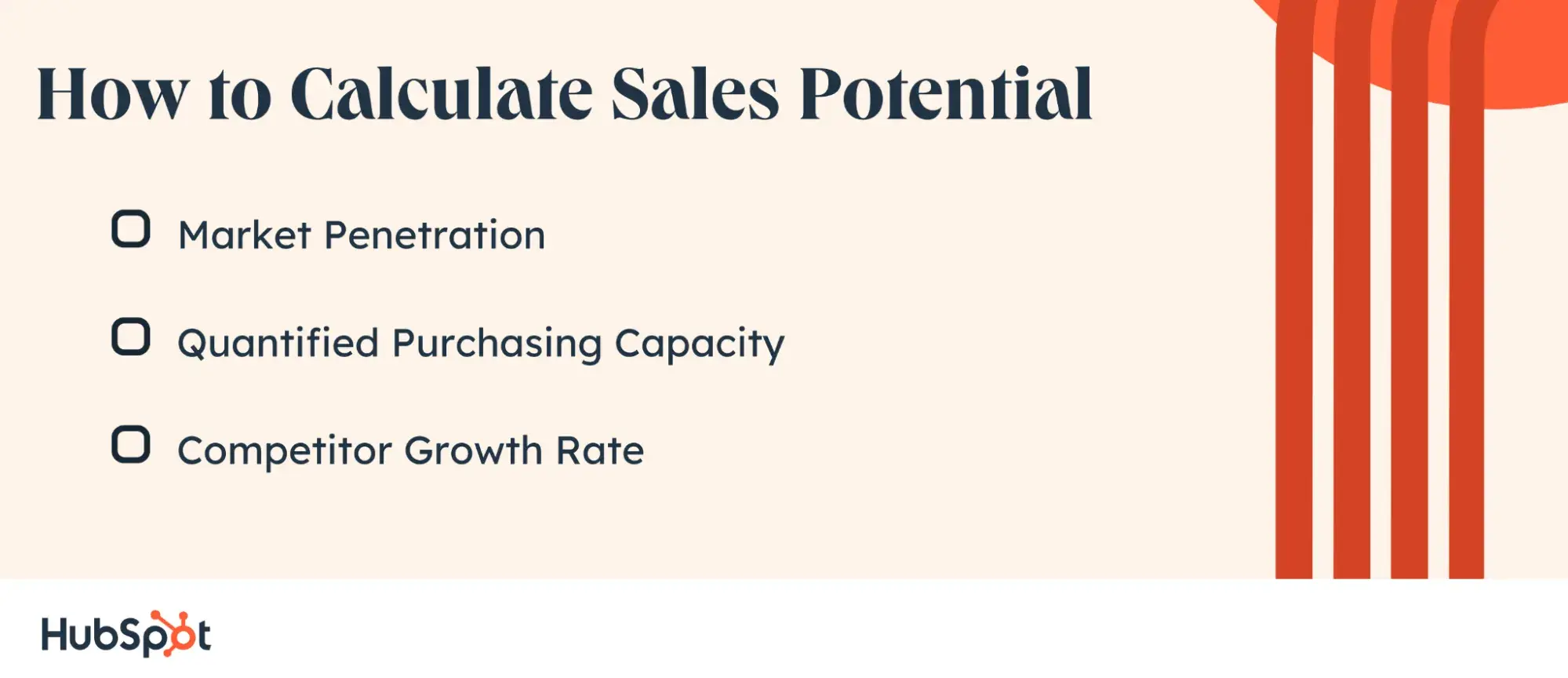Table of Contents
- What is sales potential?
- Sales Potential Use Cases
- Sales Potential Benefits
- How to Calculate Sales Potential
- Example of Sales Potential
- Don’t Skip Sales Potential
What is sales potential?
Sales potential is the theoretical maximum revenue a company can achieve within a specific market and over a defined duration, taking into account factors like buyer needs, budgets, market trends, and competitive positioning.
Sales potential can be confused for market potential, so I think it’s important to understand the difference between the two. As I stated above, sales potential shows the maximum amount of sales a company can bring in factoring all potential buyers within their specific product category. Market potential factors in the total sales potential of all competitors within a specific market.
Essentially, sales potential occurs at the company and product level, and market potential occurs at the broad product market level. Knowing your company’s sales potential will inform a wide variety of decisions I’ll touch on next.
Sales Potential Use Cases

1. Identify Promising Markets
If you’re reading this blog, your job is probably to sell — and you might even be allocated a specific location in which to do it. If you aren’t assigned a territory, however, deciding where to focus your limited efforts can be a daunting task.
With a good understanding of sales potential, however, you can identify untapped or undersold markets where the demand for your product or service will generally be higher.
When I was selling software to digital marketing agencies, I had better “luck” after identifying three specific regions with a relatively high concentration of our ICPs where we nonetheless had few customers. By acting on this unrealized sales potential, I was able to enjoy a higher close rate without making any other changes to the sales process.
2. Prioritize New Products
Particularly in the software space, customers will always be clamoring for one feature or another. While there’s an understandable tendency to prioritize development for your highest-grossing customers or oldest accounts, I would argue that sales potential is a much more important metric to consider.
If you have 10 current customers who would double their spending for feature A, but your best customer is asking for feature B, deciding what to build is actually a relatively simple matter. Will twice as much revenue from your 10 customers offset the loss on the off chance your best account leaves? If so, feature A has a greater sales potential, and it should be prioritized.
Of course there are other considerations here, but sales potential should hold significant weight as you plan your roadmap.
3. Establish Sales Quotas
Too many sales leaders create quotas as if their competitors don’t exist. And yet, there’s a big difference between motivating people and working them to the bone with unachievable targets. To establish realistic quotas, look at the entire sales potential of a region and then consider your company’s share of the market.
You’re looking to win market share from your competitors, and a quota is a tool to do that — not an excuse to pretend you’re a monopoly. Use sales potential to align the incentives of your salespeople with realistic desired outcomes, and you’ll enjoy better retention and more sustainable long-term growth.
4. Perform Competitive Analysis
Once you have a good grasp on the total sales potential of a region, looking at your own revenue generation in the area can help you arrive at a measure of your current market share. Knowing how much of the pie you’re winning can inform all types of strategies to help you expand.
When my software company noticed our market share in a specific region was slipping below our typical threshold, we found an emerging competitor with a primary differentiating feature. By fast-tracking a similar feature for our own users, we were able to effectively stop the bleeding and focus on winning back the market in the area.
5. Forecast Revenue Accurately
All of the above use cases of sales potential combine to help you perform another key function: produce accurate revenue forecasts. By understanding new and emerging markets, bringing prioritization to the chaos in your product roadmap, establishing accurate quotas, and conducting a competitive analysis, you’ve covered a lot of the key bases involved in building a reliable revenue forecast.
Revenue forecasts are involved in a multitude of big decisions company-wide, but they’re most relevant to me for hiring purposes. In my experience, the scariest part of expanding your team is feeling responsible for other people and their livelihoods. When I’m confident in the company’s revenue forecast, I find it easier to overcome that fear and seize potential growth opportunities with new hires instead of waiting until the existing team is unable to keep up with the workload.
Sales Potential Benefits
With a well-defined notion of your sales potential, you’ll enjoy a wide variety of benefits, including the following.
Better ROI
When you have a good idea of sales potential, you can concentrate your limited resources in areas that have the best return for your business.
For example, a well-defined sales potential can show you when a given product has reached a market saturation point. While you could expand your sales team and fight hard to earn incrementally greater shares of the market, you’re likely to see a better return by investing in features to reach new customers and unlock a greater sales potential.
Research published in Harvard Business Review found that, particularly for highly digitized companies (most of them these days), market share increases don’t necessarily hold the profitability increases they used to when efficiencies of scale were more dramatic.
Minimized Risk
Expanding or establishing a presence in any market carries a certain amount of risk, but you can mitigate that risk by understanding sales potential. With knowledge of how much revenue a product can realistically generate and an understanding of the margins you need to achieve to make a go-to-market effort worthwhile, you’ll be able to make a more informed decision about how much you can realistically invest to enter a market or strengthen your position in one.
Investor Attention
Not all companies want or need outside capital, but a decade-long study from Global Corporate Venturing found that a corporate investor cuts the failure rate of a startup in half and increases the exit multiple it can expect to achieve through either acquisition or IPO.
One thing investors will need to see before writing a check? Sales potential. Your business needs to have a sales potential that’s commensurate with the funding you’re hoping to raise, whether that’s five figures for a niche, localized business or millions for a startup aspiring for hyper growth.
How to Calculate Sales Potential

Hopefully, by now, you’ve bought into the importance of sales potential, so let’s turn our focus to calculating it. The most basic sales potential formula looks at the number of potential customers available and multiples it by your unit price.
Of course, there are more complex scenarios to consider, so I’ll go over some of the different values you can arrive at when investigating sales potential.
1. Market Penetration
First, take a look at your current customer base and then divide it by the total number of potential buyers available. If you want to calculate market penetration for a specific area or demographic, look at customers that fit the given mold and divide by all the unconverted prospects out there who look alike. This practice will give you a rough indication of how much of a given market you’ve been able to capture.
If the resulting value is low, that’s not necessarily a bad thing. It could even mean your company has the potential to tap into a large base of buyers who could be a good fit for your product but haven’t made a purchase yet.
If this value is high, you’ve saturated your target market. It’s a sign of competitive dominance, but it may also indicate a good time to introduce other offerings or focus on the upsell to keep buyers engaged.
2. Quantified Purchasing Capacity
What is the maximum number of purchases a customer can make from your company in one year? The answer is known as the quantified purchasing capacity for your business.
For example, let’s say I work for a supplement company that offers powdered drink supplements. I offer three main products: a morning drink, an afternoon drink, and an evening drink. Each of the products comes with 30 days worth of servings, and when taken as intended, customers would take one serving of each drink each day.
To take all three of my supplements for a year, a customer would purchase three drink canisters per month times 12 months out of the year — yielding my quantified purchasing capacity of 36 units per year. If each product costs $30 per unit and customers buy 36 units per year, my beverage company can anticipate bringing in as much as $1,080 per customer each year.
Now, I’d look at this figure and compare it to the average purchase my customers make. If I find my average customer purchases just one drink canister per month, I can adjust my sales forecast to account for the typical purchasing habits.
To bring in more revenue, I might focus my sales strategy on encouraging existing customers to purchase the entire product line. This initiative offers a way to boost overall sales without having to go out and capture new customers.
3. Competitor Growth Rate
As you do the necessary research to understand your company’s sales potential, you should take into account the growth rates of your competitors. If other players in the market experienced significant growth in a specific product category, their trajectory can provide important information about the consumers you have in common and the potential sales that could be achieved.
If your growth rates are lagging far behind your competitors, that could be an indication that your company has internal issues that need to be addressed in order to reach greater sales potential.
Example of Sales Potential
Now, let’s walk through a more in-depth example of sales potential for a fictional company called BossCo.
BossCo is a company that creates business management software for creative entrepreneurs. This company offers annual and monthly plans for their signature platform with additional upgrades and integrations customers can purchase to help the software work smoothly and efficiently with other systems.
When looking to understand their sales potential, BossCo factors in the following pieces of data:
- Seasonality. They notice their subscriber base goes up in the fall and drops in the summer.
- Existing customer data. The average BossCo customer is subscribed to their monthly software subscription and has purchased one out of five possible upgrades.
- Competitor analysis. BossCo currently has one main competitor who has a hold on equal market share, and is growing at a similar rate.
- Market demographics. BossCo commissioned a study of 1,000 small business owners in their target market and found only 15% of those surveyed use a platform to oversee and automate business management tasks.
With this data in mind, the BossCo team now understands the needs and habits of their customer base and is relieved to not be behind the growth curve of their main competitor.
With only 15% of their target demographic currently using the type of software they offer, with roughly half of them likely being BossCo customers, BossCo’s team can infer they have tapped into about 7.5% of their target market with room to grow as they expand their offerings and customer base.
To tap into a greater share of the market, BossCo might conduct more research on the 85% of survey respondents who aren’t using business management software and implement sales tactics to win over these potential buyers and increase market share.
Don’t Skip Sales Potential
I’ve seen companies opt not to bother with sales potential, thinking it’s an unnecessary metric when the goal will always be to sell “as much as possible.” Unfortunately, those organizations end up missing out on a critical calculation that informs decisions well beyond the sales department.
Whether you have the resources to devote to a more sophisticated measure of sales potential or all you can muster is a Google Sheet based on some educated assumptions, I think taking the time to quantify this figure pays off pretty quickly when it yields a clearer roadmap, smarter asset allocation, and an informative competitive analysis of the market.
And if that analysis shows that you’re leaving sales on the table, download this free Close Rate Calculator to see where you’re losing your prospects and how you can bring home a bigger slice of the pie.
Sales Forecasting
.png?width=112&height=112&name=Sales%20Conversion%20and%20Close%20Rate%20Calculator%2001-300%20(1).png)


![How to Choose the Right Forecasting Technique [+ Expert Insight and Data]](https://53.fs1.hubspotusercontent-na1.net/hubfs/53/forecasting-methods-1-20241205-4072635.webp)
-Feb-24-2025-07-49-23-4986-PM.png)






![I Took a Deep Dive Into Trend Forecasting: Here’s What I Learned [+ Expert Tips]](https://53.fs1.hubspotusercontent-na1.net/hubfs/53/trend-forecasting-1-20241114-1048511.webp)
